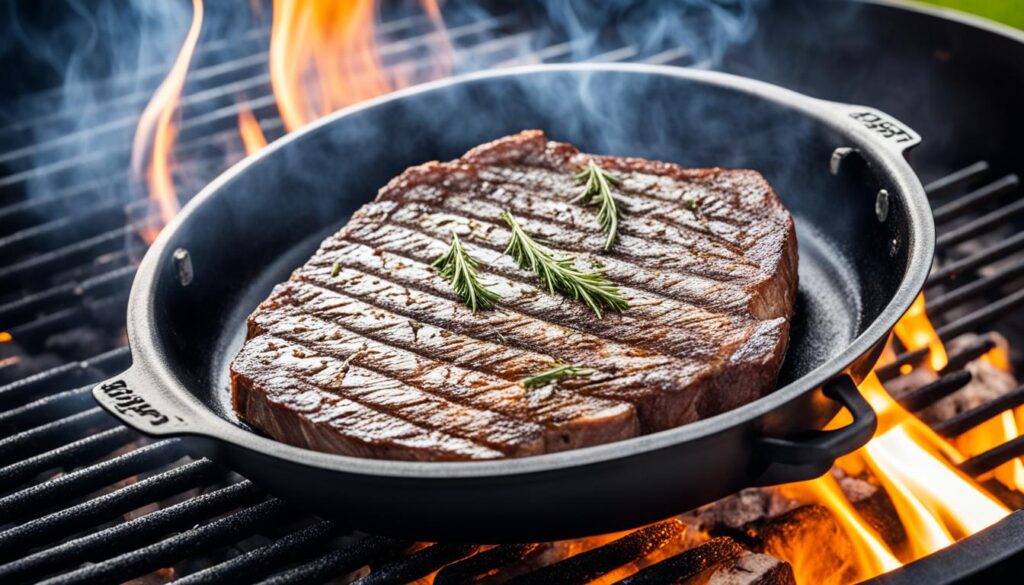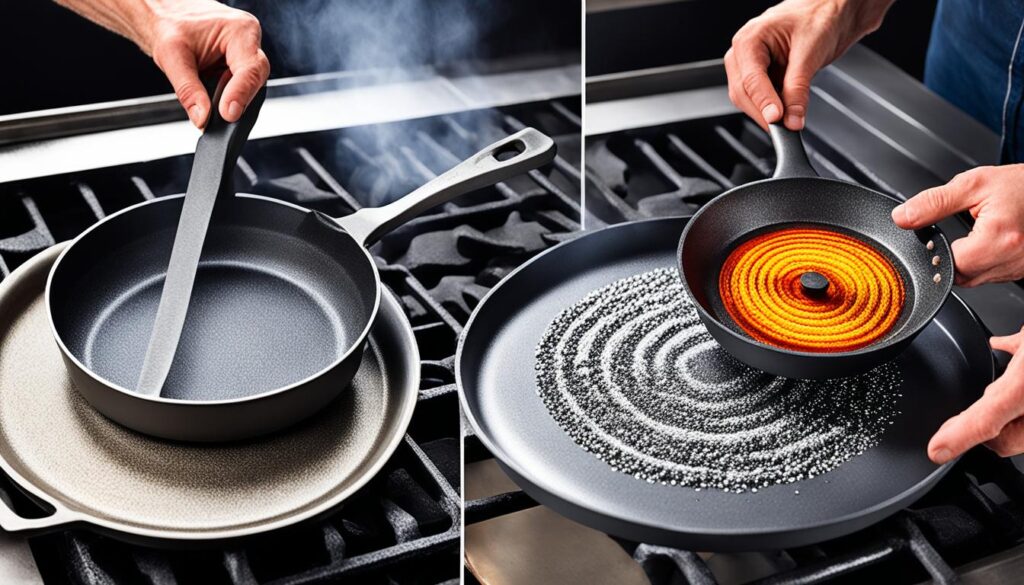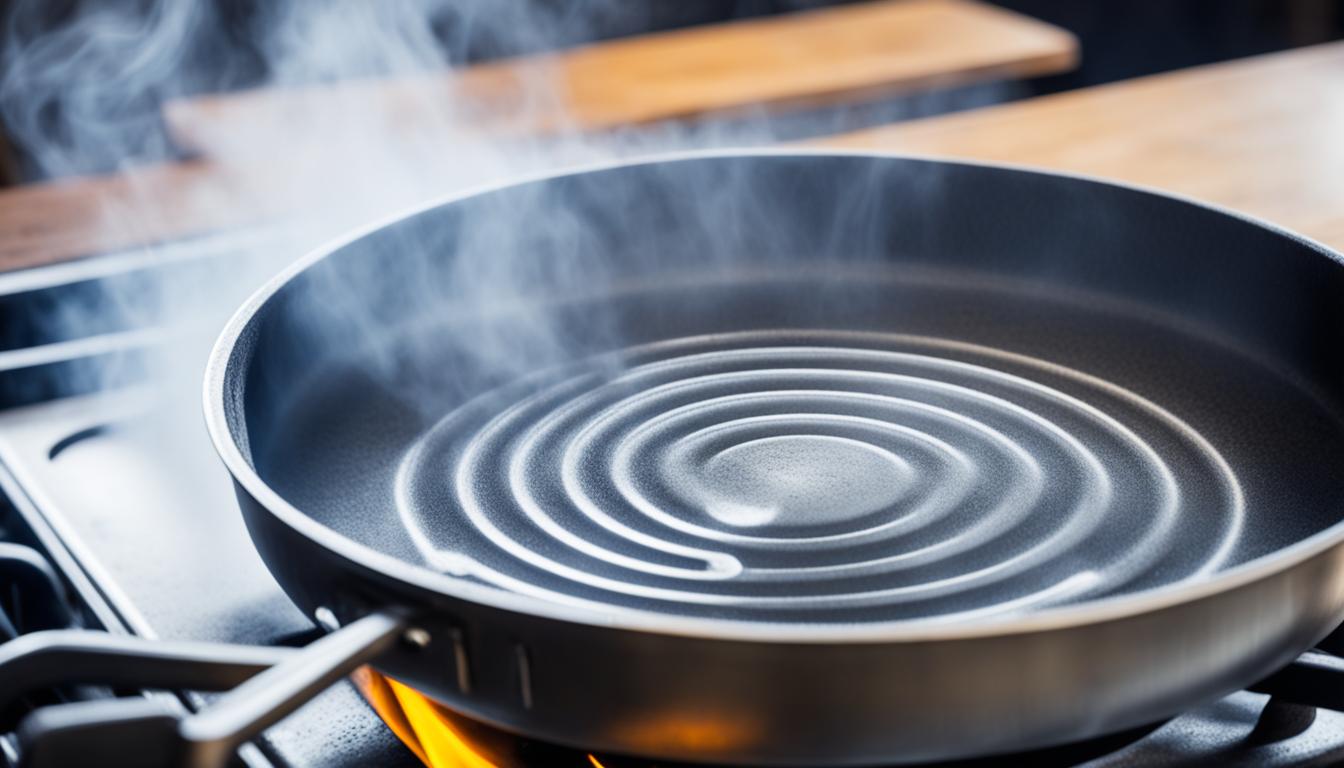When it comes to choosing the perfect cookware, carbon steel pans are a standout alternative to traditional cast iron. With their exceptional qualities and versatility, carbon steel pans have become a favorite among chefs and home cooks alike.
So, what sets carbon steel pans apart from their cast iron counterparts? Well, for starters, carbon steel pans offer a smoother surface and a more closed grain structure, resulting in excellent non-stick properties. This means you can enjoy hassle-free cooking without worrying about your food sticking to the pan.
Another advantage of carbon steel pans is their slightly thinner and lighter construction. This makes them ideal for sautéing, as they heat up quickly and provide easy maneuverability in the kitchen. The low flared sides of carbon steel pans also make them perfect for stovetop cooking, allowing for effortless tossing and flipping of ingredients.
Similar to cast iron, carbon steel pans require seasoning to enhance their performance and longevity. With proper care, these pans can last a lifetime, making them a worthy investment for any kitchen.
So, whether you’re searing steaks, sautéing vegetables, or whipping up a delicious stir-fry, carbon steel pans are up to the task. Their superior non-stick properties, even heating, and versatility make them a must-have addition to your cookware collection.
The Benefits of Carbon Steel Pans
When it comes to cookware, carbon steel pans offer a range of benefits that make them a top choice for culinary enthusiasts and professional chefs alike. From their superior non-stick properties to their even heating and versatility in the kitchen, carbon steel pans are a valuable addition to any cookware collection.
1. Superior Non-Stick Properties
One of the standout features of carbon steel pans is their exceptional non-stick properties. The smooth surface of these pans allows for easy food release, making flipping and tossing ingredients a breeze. Say goodbye to stubborn food residues and hello to effortless cooking and cleaning.
2. Even Heating
Carbon steel pans excel in providing even heat distribution. This means that every inch of the pan heats up evenly, ensuring consistent cooking results. Whether you’re searing a steak or sautéing vegetables, you can trust that your food will be cooked to perfection.
3. Versatility
Carbon steel pans are incredibly versatile, allowing you to use them on any heat source. Whether you prefer cooking on a stovetop, in the oven, or on a grill, these pans can handle it all. From searing meats to baking delectable desserts, carbon steel pans are up for any culinary challenge.
4. Durability
With their robust construction, carbon steel pans are built to last. These pans can withstand high temperatures without warping or degrading, making them a reliable choice for intense cooking techniques. Invest in a carbon steel pan, and you’ll have a trusty kitchen companion for years to come.
| Benefits of Carbon Steel Pans |
|---|
| Superior non-stick properties |
| Even heating |
| Versatility |
| Durability |
Whether you’re a culinary enthusiast or a professional chef, carbon steel pans offer a host of benefits that can elevate your cooking experience. With their non-stick properties, even heating, versatility, and durability, these pans are a true kitchen essential. Experience the joy of cooking with carbon steel pans and unlock a world of delicious possibilities.

The Difference Between Carbon Steel and Cast Iron
While carbon steel and cast iron have many similarities, there are some key differences between the two. Carbon steel is made from iron and carbon, while cast iron is made through the casting of molten iron and carbon alloy. The composition of these materials affects their properties and performance in the kitchen.
One significant difference lies in the surface texture. Carbon steel has a smoother surface and a more closed grain structure, resulting in better non-stick properties. This makes carbon steel pans excellent for cooking delicate foods that require minimal sticking, such as eggs and fish. On the other hand, cast iron has a more textured surface, which is better suited for baking and creating those coveted crispy edges on dishes like cornbread and frittatas.
Another distinction is the weight and thickness of the pans. Carbon steel pans are slightly thinner and lighter than cast iron pans, making them easier to handle and maneuver in the kitchen. This makes carbon steel pans particularly suitable for sautéing, where quick movements are often required. Cast iron pans, with their heft and thickness, excel in heat retention and distribution, making them ideal for slow cooking and searing larger cuts of meat.
Lastly, the shape of the pans differs between carbon steel and cast iron. Carbon steel pans typically have low flared sides, allowing for easy access to food and efficient stirring or flipping. Cast iron pans, on the other hand, usually have steeper sides, which provide more volume and depth for dishes that require liquid ingredients or sauces.
The Comparison Table
| Features | Carbon Steel | Cast Iron |
|---|---|---|
| Material Composition | Made from iron and carbon | Made through the casting of molten iron and carbon alloy |
| Surface Texture | Smooth with a closed grain structure | Textured |
| Weight and Thickness | Slightly thinner and lighter | Heavier and thicker |
| Shape | Low flared sides | Steeper sides |
It’s important to consider these differences when choosing between carbon steel and cast iron pans. The decision ultimately depends on your cooking preferences and the specific dishes you enjoy preparing. Both materials offer unique benefits and can enhance your culinary experience in their own ways.

Quote
“The difference in surface texture, weight, and shape between carbon steel and cast iron pans can significantly impact their performance in the kitchen. Understanding these distinctions allows us to make more informed decisions when selecting the right cookware for our culinary adventures.”
Durability and Maintenance of Carbon Steel Cookware
When it comes to cookware, durability is key. You want a pan that can withstand the heat and last for years to come. That’s why carbon steel cookware is a top choice for many professional chefs and home cooks alike. Not only is carbon steel highly durable, but it also offers excellent heat distribution and retention for precise cooking control.
Carbon steel cookware is made with a combination of iron and carbon, giving it the strength and resilience needed to handle high temperatures without warping or degrading. This means you can confidently crank up the heat and sear a perfectly juicy steak or crisp up your favorite veggies with ease.
To ensure the longevity of your carbon steel pans, proper maintenance is crucial. Regular seasoning is necessary to maintain their non-stick properties and protect against rust. Seasoning involves applying a thin layer of oil to the surface of the pan and heating it to create a natural non-stick coating. This process not only enhances the performance of the pan but also builds up a protective barrier against moisture and rust.
When it comes to cleaning carbon steel cookware, hand-washing is recommended. Avoid using harsh abrasives or dishwasher, as they can strip away the seasoning and cause damage to the pan. Instead, gently scrub the pan with a soft sponge or brush and warm water. After washing, make sure to dry the pan thoroughly to prevent any moisture from causing rust.
It’s important to note that carbon steel pans should not be exposed to acidic foods for prolonged periods. Acidic ingredients can break down the seasoning and affect the performance of the pan. If you do cook with acidic ingredients, make sure to clean and re-season the pan afterwards to maintain its durability and non-stick properties.
With proper care and maintenance, carbon steel cookware can provide you with a lifetime of exceptional performance in the kitchen. So invest in a high-quality carbon steel pan, season it well, and enjoy the benefits of durable and versatile cookware that will stand the test of time.
| Benefits of Carbon Steel Cookware | Durability | Maintenance |
|---|---|---|
| Highly durable | Can withstand high temperatures without warping or degrading | Requires regular seasoning to maintain non-stick properties and protect against rust |
| Excellent heat distribution and retention | Provides precise cooking control | Hand-washing recommended |
| Versatile for various cooking techniques | Avoid prolonged exposure to acidic foods |
Cooking with Carbon Steel vs Cast Iron
When it comes to cooking, having the right tools can make all the difference. Two popular choices for cookware are carbon steel pans and cast iron pans. While both materials have their advantages, understanding their differences can help you make an informed decision in the kitchen.
Carbon steel pans are known for their ability to handle high-heat cooking techniques with ease. Whether you’re searing steaks or charring vegetables, these pans heat up quickly and respond well to temperature changes. This allows for precise cooking control and results in deliciously cooked meals.
“The heat responsiveness of carbon steel pans is unmatched. It’s like having a chef’s secret weapon in your kitchen!”
On the other hand, if baking is your forte, cast iron pans are the way to go. They excel at retaining and distributing heat evenly, making them ideal for achieving consistent results when baking bread or making a deep-dish pizza. Additionally, the substantial thermal mass of cast iron pans makes them perfect for searing large cuts of protein to perfection.
Both carbon steel and cast iron pans require seasoning to develop a natural non-stick surface and enhance their durability. Seasoning involves treating the pans with a thin layer of oil and subjecting them to high heat, creating a protective layer that prevents rust and enhances their performance.
When it comes to versatility, both carbon steel and cast iron pans can be used on any heat source, including stovetops, ovens, and grills. They are durable and built to last, providing many years of cooking enjoyment.
Carbon Steel vs Cast Iron: A Comparison
| Carbon Steel Pans | Cast Iron Pans |
|---|---|
| Excellent for high-heat cooking | Ideal for baking and heat retention |
| Quick heat-up time | Even heat distribution |
| Perfect for precise cooking control | Great for searing large cuts of protein |
| Require regular seasoning | Require regular seasoning |
| Can be used on any heat source | Can be used on any heat source |
Ultimately, the choice between carbon steel and cast iron pans depends on your specific cooking needs and preferences. If you enjoy high-heat cooking or want precise control over your dishes, carbon steel pans are the way to go. On the other hand, if baking or searing large cuts of protein is your focus, cast iron pans are the perfect choice.
Whichever material you choose, both carbon steel and cast iron pans are excellent additions to any kitchen. They offer superior heat retention, durability, and versatility, allowing you to create delicious meals every time you step into the kitchen.
Best Uses for Carbon Steel Pans
When it comes to carbon steel pans, their versatility and performance shine through in various cooking applications. These pans excel in sautéing vegetables, thanks to their quick heat-up time and even heat distribution. Their efficient conduction allows for precise control and uniform cooking, ensuring perfectly cooked veggies every time.
Not limited to vegetables, carbon steel pans are also ideal for searing meats to perfection. Their exceptional heat retention and even heating properties enable a beautiful caramelization on the outside while keeping the meat tender and juicy on the inside. Achieving that perfect sear becomes a breeze with carbon steel pans.
Aside from stovetop cooking, these pans easily transition to oven and grill use. Whether you’re baking, broiling, or grilling, carbon steel pans can handle the heat with ease. The ability to use them on different heat sources makes them incredibly versatile for various cooking techniques, allowing you to explore a wide range of mouthwatering recipes.
With their lightweight design and maneuverability, carbon steel pans are excellent for high-heat cooking methods like stir-frying and blackening. Their quick response to temperature changes and ease of flipping and tossing ingredients make them a go-to choice for achieving those desired flavors and textures in stir-fried dishes.
In summary, carbon steel pans are indispensable in the kitchen for sautéing, searing, baking, grilling, stir-frying, and blackening. Their wide range of uses, even heat distribution, and lightweight design make them a must-have addition to any cookware collection. Whether you’re a professional chef or a cooking enthusiast, carbon steel pans will elevate your culinary creations to new heights.
